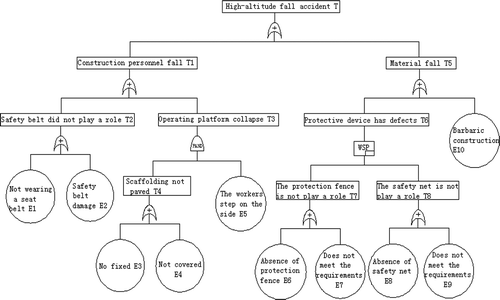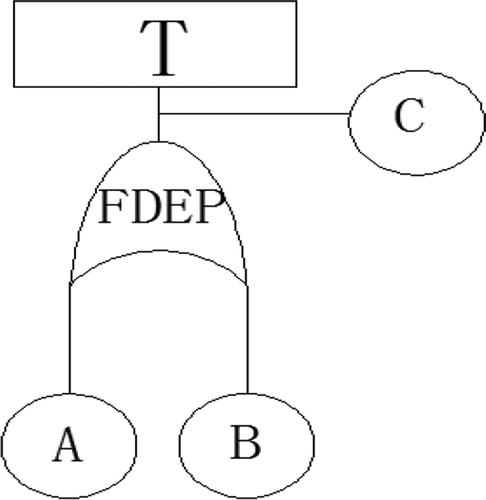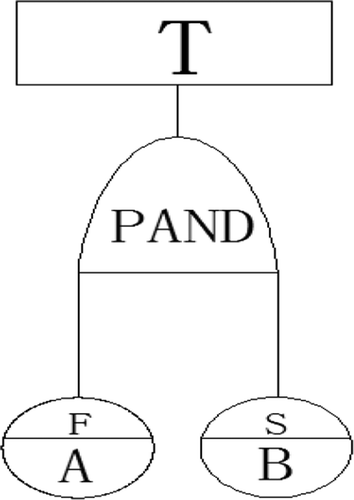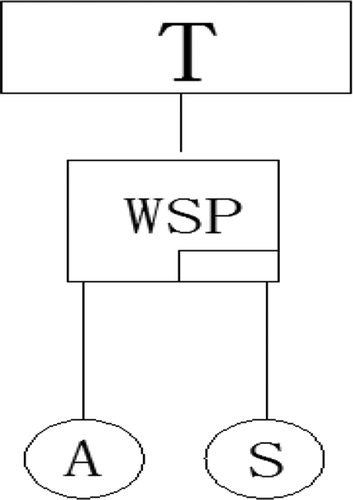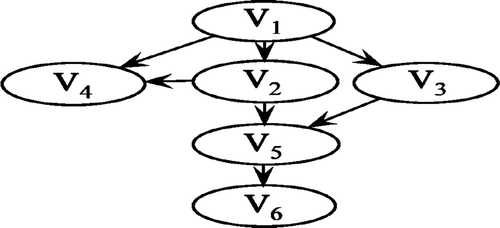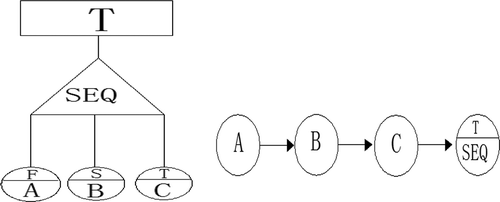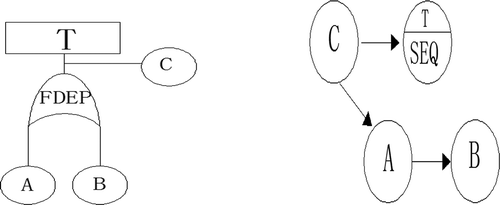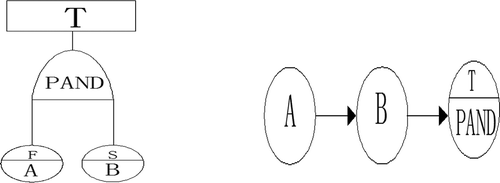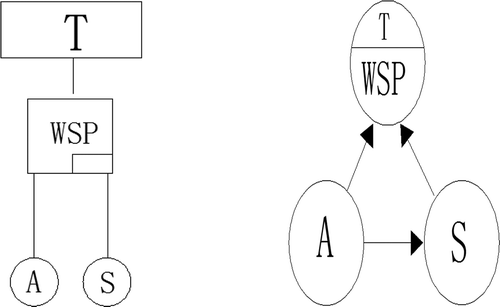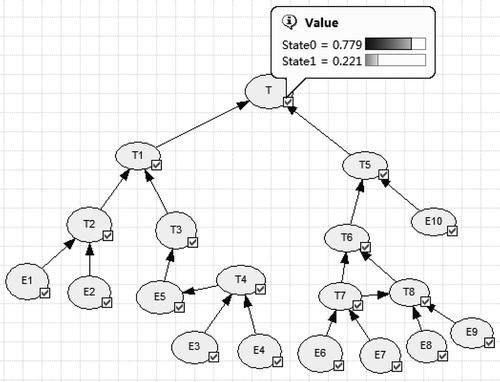 ?Mathematical formulae have been encoded as MathML and are displayed in this HTML version using MathJax in order to improve their display. Uncheck the box to turn MathJax off. This feature requires Javascript. Click on a formula to zoom.
?Mathematical formulae have been encoded as MathML and are displayed in this HTML version using MathJax in order to improve their display. Uncheck the box to turn MathJax off. This feature requires Javascript. Click on a formula to zoom.ABSTRACT
The occupational safety risk of high-altitude fall accident in architecture construction engineering is dynamically changeable. Considering these dynamic changes, how to make a qualitative and quantitative analysis of the changing trends of the occupational safety risk, and providing the basis for the latter occupational safety risk control measures, become the main target of the dynamic risk management of construction projects. From the point of view of dynamic change, this paper modularizing analyzes the presented model, quantitative analyzes the impact of occupational safety risk of the whole construction system, proposes some methods about transforming the dynamic fault-tree module into the Bayesian network model, and puts forward a novel occupational safety risk analysis method of high-altitude fall accident in construction project management based on integrated Dynamic Fault Tree Analysis (DFTA) and Bayesian network method. The presented method and detailed realization process can offer a useful reference for occupational safety risk management of high-altitude fall accident in architecture construction engineering.
Graphical Abstract

1. Introduction
The architecture construction engineering has the characteristics of long duration, complexity, changeable environment, multi participation and so on. These characteristics determine that architecture construction engineering is dynamic and interrelated; the occupational safety risk of high-altitude fall accident in architecture construction engineering is also dynamically changeable.
The occupational safety risk of the project in different stages of construction is different; generally, with the increase of the construction height, the occupational safety risk will increase, and the occupational safety risk of the main stage is much more than that at the decoration stage. Due to construction projects are combined with a lot of different construction stages according to a certain time and logical order, so the former construction activity does not attain the standard, the next construction activities will have potential occupational safety hazards. Smoothly realizing the goals of progress, occupational safety, and the period of the entire construction system needs the mutual coordination of many construction stages. The traditional occupational safety risk analysis methods are not specifically aimed at the dynamic, relevant and time sequence and using the separation, local, static attitude to look at occupational safety risk.
Methodological approach: considering the dynamic changes of occupational safety risk factors of architecture construction engineering, how to make a qualitative and quantitative analysis of the changing trends of the occupational safety risk factors, and providing the basis for the latter occupational safety risk control measures, become the main target of the dynamic risk management of architecture construction engineering. From the point of view of dynamic change, this paper modularizing analyzes the presented model, quantitative analyzes the impact of occupational safety risk of the whole construction system, presents some methods about transforming the dynamic fault tree module into the Bayesian network model, and presents a novel occupational safety risk analysis method of high-altitude fall accident in construction project management based on integrated Dynamic Fault Tree Analysis (DFTA) and Bayesian network method.
2. Analyzing related references
Fault tree analysis (FTA) is widely used for the reliability analysis of systems (Vesely et al. Citation2002) (Kabir Citation2017). Although fault tree models are well structured and easily understood, the classical FTA models are generally unable to model some aspects of system behavior, e.g., priorities or functional and stochastic dependencies between events (Kabir et al. Citation2018). These can be looked as shortages of classical FTA. The modeling capability of classical fault trees has been enhanced through several extensions, such as dynamic fault trees (DFTs) (Dugan, Bavuso, and Boyd Citation1992) and Pandora Temporal Fault Trees (TFTs) (Walker Citation2009). Merle et al. (Citation2010) focused on a sub-class of Dynamic Fault Trees (DFTs). Merle, Roussel, and Lesage (Citation2011) presented an algebraic framework allowing algebraically modeling dynamic gates and determining the structure–function of any Dynamic Fault Tree (DFT). Rahme and Xu (Citation2015) adopted the dynamic fault tree (DFT) formalism to model the system reliability before and during a software rejuvenation process in an aging cloud-based system. For instance, in DFTs, dynamic gates like Functional Dependency (FDEP), Priority-AND (PAND), and SPARE gates are introduced to model the dynamic failure behavior of systems. DFTs are primarily analyzed quantitatively, and for the analysis of fault trees, especially the DFTs, different approaches like algebraic (Merle et al. Citation2016; Merle et al. Citation2010), Markov chain-based (Dugan, Bavuso, and Boyd Citation1993; Boudali, Crouzen, and Stoelinga Citation2010), stochastic (Zhu et al. Citation2017; Zhu et al. Citation2016), Bayesian network-based (Codetta-Raiteri and Portinale Citation2017; Boudali and Bechta Dugan Citation2006), Sequential Binary Decision Diagram (SBDD)-based (Xing, Tannous, and Dugan Citation2012; Ge et al. Citation2015) approaches have been developed (kabir et al. Citation2020).
Dynamic fault tree transforming to Bayesian network model can effectively avoid some disadvantages, such as state space explosion and transformation program error, with respect to the traditional fault tree transformation to the Markov chain method. It also benefits from the inherent advantages of Bayesian networks, such as probability updating, etc. (Xin Ge, Tang, and Zhe Citation2009). Lee, Park, and Shin (Citation2009) studied the application of the Bayesian network model in risk management of large engineering projects. Manno et al. (Citation2012) presented a high-level modeling framework that exceeds all these limitations, based on Monte Carlo simulation. Chiacchio et al. (Citation2013) tested the feasibility of a composition algorithm based on a Weibull distribution. In order to overcome the limitation of the traditional method, Leu and Chang (Citation2015) proposed a supply chain risk assessment model based on the fault tree transformation. Chena and Leub (Citation2014) have established a risk assessment model of bridge construction based on fault tree transformation. Rauzy and Blériot-Fabre (Citation2015) proposed a direct translation of dynamic fault trees into guarded transition systems. Abdo and Flaus (Citation2016) provided a simulation technique based on MCS (Monte Carlo Simulations) to solve dynamic fault tree taking into account epistemic uncertainty in the determination of the failure rate of basic events. Merle, et al. (Citation2016) focused on the quantitative analysis of Dynamic Fault Trees (DFTs) by means of Monte Carlo simulation. Yevkin (Citation2016) used Approximate Markov chain method for dynamic fault tree analysis for both reparable and non-reparable systems.
The Bayesian network (simply referred to as BN), also known as Belief (probability distribution) network, is a directed acyclic graph (DAG), which is formed by the nodes representing variables and directed edges connecting these nodes. Leu and Chang (Citation2015) presented the development of a fall risk assessment model for SC (steel construction) projects by establishing a Bayesian network (BN) based on fault tree (FT) transformation. Sutrisnowati, Bae, and Song (Citation2015) proposed a method to generate a Bayesian network from a process model which can be discovered from event logs in port information systems. Miyauchi and Nishimura (Citation2016) constructed Bayesian networks connecting the findings from a physical examination and questionnaire on daily lifestyle choices. Laitila and Virtanen (Citation2016) elaborated on the ranked nodes method (RNM) that is used for constructing conditional probability tables (CPTs) for Bayesian networks consisting of a class of nodes called ranked nodes. Mohammadfam et al. (Citation2017) presented a model for managing and improving occupational safety behavior of employees using the Bayesian networks approach. Chebila (Citation2018) applied the Bayesian networks method to estimate the occurrence frequency of failures and consequences in a straightforward way. Haddawy et al. (Citation2018) explored the use of Bayesian networks to model malaria. Tabar and Elahi (Citation2018) combined the Bayesian networks (BNs) and the simulated annealing algorithm. Dąbrowski and Górski. (Citation2019) was to determine the influence of the milling tool setup on occupational safety hazards associated with a kickback in furniture making.
The dynamic risk factors for the entire construction project will have different effects. When dynamic changes of construction project risk factors, how to qualitative and quantitative analysis of the change trend of risk sources, as well as the influence on the reliability of the whole system, and to provide a basis for the risk control measures, become the main target of dynamic risk management of architecture construction engineering. On the basis of above research achievements, from the point of view of dynamic change, this paper modularizing analyzes the presented model; transforms the dynamic fault tree module into the Bayesian network model to quantitatively analyze the impact of occupational safety risk events of the whole construction system, and presents a novel occupational safety risk analysis method of high-altitude fall accident in construction project management for decision-making based on integrated Dynamic Fault Tree Analysis (DFTA) and Bayesian network method.
3. The dynamic fault tree model of occupational safety risk analysis of high-altitude fall accident
Among the different probabilistic risk assessment (PRA) methods, FTA is the most-widely used approach for system safety and reliability evaluation. Fault tree analysis (FTA) is a quantitative risk analysis method and can be applied to major unwanted events (Yazdi, Kabir, and Walkerb Citation2019). FTA method is an effective tool for the occupational safety analysis of complex system, it looks the fault status that we mostly do not want to happen as the goal of fault analysis system, then look for factors that lead to the occurrence of the fault, and looks for these next-level factors, until the original factors that we do not want to further process. In this method, the top-down analysis approach is used to find the logical relationship of the top event and all kinds of intermediate events, bottom events, etc. (embodying internal component failure, external environment changes and steeplejack error factors).
Using FTA it is possible to determine the probability of any undesired events, also known as top event, given the probability of the basic events, which are the lowest-level event causes. Therefore, it is necessary to quantify the failure probability of each basic event to be able to measure the probability of the top event. The criticality of the basic events can also be determined by calculating their relative contributions to the occurrence of the top event (Yazdi, Kabir, and Walkerb Citation2019). In the DFTA (dynamic fault tree analysis) method, some dynamic logic gates (such as sequence enforcer gates, functional dependency gates, priority and gates, cold spare gates, warm spare gates and so on) are added, which can help to analyze the dynamic and sequential functions of the system.
takes the occupational safety risk factors of high-altitude fall from the operating platform as an example. This paper establishes a dynamic fault tree. This system contains two dynamic logic gates, the priority and the gates of T3 and the warm spare gates of T6.
Some contents of can be explained as follows:
(1) Sequence Enforcer (SEQ) gates of architecture construction engineering
Multiple bottom events (or intermediate events) that may cause the system to fail must occur and in a certain sequence. If disrupting the order of some bottom events (or intermediate events), the top event will not occur. This gate is shown in .
(2) Functional dependencies (FDEP) of architecture construction engineering
The function dependency gate is composed of more than one basic event and a trigger event. The occurrence of the trigger event will certainly cause the occurrence of all other basic events and will lead to the occurrence of the top event, which causes the whole system’s failure. However, if all the relevant basic events occur, and the trigger event does not occur, the system will not fail, as shown in .
(3) Priority and (PAND) gates
Priority and gate refers to two bottom events or intermediate events that may result in the failure of the system in both occurring and one of the events preceding the other one event (or coincidence), will cause the fault occurrence, reversing the order or any one event does not occur can not lead to the failure, as shown in .
(4) Warm spare (WSP) gates
Warm spare gates have one basic event and one or more optional basic events. Basic events occur in entering the work state from the beginning of the system, and the basic optional events are looked as an alternative to the basic event, and when all the basic events occur, the warm spare gates start to work. Before entering the working condition, there is a certain failure rate, and the failure probability is greater than zero. In contrast to the warm spare gates is cold spare gates, that is, it will not fail before entering the working state, as shown in .
To solve complex system fault tree, our paper focuses on the construction of a Bayesian network model for dynamic fault tree and applies it to the occupational safety risk fault tree analysis of high-altitude fall accident in architecture construction engineering.
4. The presented integrated dynamic fault tree analysis (DFTA) and Bayesian network method
4.1. Dynamic fault tree analysis (DFTA) based on Bayesian network transformation
Dynamic fault tree transforming to the Bayesian network model can effectively avoid some disadvantages, such as state space explosion and transformation program error, with respect to the traditional fault tree transformation to the Markov chain method. It also benefits from the inherent advantages of Bayesian networks, such as probability updating, etc.
The Bayesian network (simply referred to as BN), also known as Belief (probability distribution) network, is a directed acyclic graph (DAG), which is formed by the nodes representing variables and directed edges connecting these nodes. shows a simple Bayesian network example of six nodes (not include conditional probability distribution).
The Bayesian network is composed of nodes Vi and the arrow line connecting the nodes. Node Vi represents variables in the system, which is an abstract representation of a subsystem, component or personnel problems of a dynamic fault tree. The arrow lines between the nodes indicate the incidence relation between the variables. Among them, the node that pointed out by the line is known as the parent node. The node that pointed by the line is called a sub node. A node that has no parent node is called the root node (such as node V1 in ), and the nodes without child nodes are called leaf nodes (such as node V4, V6 in ), and these nodes and the arrow lines are composed of a Bayesian network. In the directed acyclic graph, there is a conditional independence assumption, namely for arbitrary node Vi, in the given parent node set pa (Vi), Vi and non-descendant node set A (Vi) is conditionally independent:
The conditional probability distribution that related to each node is indicated by P. From the conditional independence assumption of Bayesian networks can be known, the conditional probability distribution can use P (Vi| Pa (Vi)) to describe, it is an expression of the quantitative relationship between node and its parent node. Through the given prior probability distribution of the root node and the conditional probability distribution of the non-root node, then can calculate the probability of the top event.
According to the logical relationship of the dynamic fault tree, the two-state Bayesian network mapping models are modeled, that is, the nodes in the Bayesian network can only have two states: 1 indicates that the event occurring and 0 indicates that the event does not occur. Each basic event in the dynamic fault tree subjects to a node in a Bayesian network (repeated occurrence of the basic event is merged into one node), and the probability of occurrence of the fault tree’s bottom event corresponds to the prior probability of the node in a Bayesian network, the logic gate of the fault tree corresponds to the directed arc of a Bayesian network, to represent the logical relationship of the event (connection strength). Through the prior probability of the root node, we can calculate the conditional probability of each leaf node, so as to get the probability of the top event from the bottom up.
For the root node, the occurrence probability of the bottom event in the fault tree, the failure rate of the root node can be obtained by combining the expert scoring method and the data analysis, and then can calculate the prior probability distribution of the root node
(Assuming that the bottom events are exponentially distributed).
Among them, indicates that
fail in the interval
,
indicates the time interval;
indicates that
does not fail in the task time T0.
Here is the transformation of the dynamic logic gate into Bayesian networks introduced above, the transformation of static logic gate (And gates, Or gates, etc.) has been described in detail in the literature, here do not repeat them.
Sequence Enforcer (SEQ) gates
The Bayesian network transformation of Sequence Enforcer is shown as .
According to the temporal logic relationship of the sequence enforcer gates, we can get the corresponding Bayesian network, and the conditional probability of node B and node C is the same, takes node C as an example, its conditional probability distribution is:
The conditional probability of root node T is:
It also can be calculated according to the rule of bucket elimination, so as to get the probability of top event T:
Functional dependencies gates:
The Bayesian network transformation of Functional dependencies is shown as . The conditional probability of node A and node B are the same, takes node A as an example, its conditional probability distribution is:
The Bayesian network transformation of Priority and Gate is shown as . The conditional probability of root node T is:
The conditional probability of top event T is:
(3) Warm Spare Gates
The Bayesian network transformation of Warm Spare Gates is shown as .
The conditional probability of node S is: ( indicates the sleep factor of the warm spare gates S)
The conditional probability of root node T is:
4.2. The probability of the top event T
In the Bayesian network transformed by dynamic fault tree, it is no need to solve the cut set, and the joint probability distribution can be used to calculate the occurrence probability of the top event T:
There the node corresponds to the intermediate events and the bottom events in the dynamic fault tree,
is used to show whether the event occurs or not,
is the number of nodes in the Bayesian network[4]. The Bayesian network model also can be used to diagnose the main cause of the accident after the failure occurring, and to verify the posterior probability of each node in the dynamic fault tree, in addition to its reasoning ability. For example, after the event
, the posterior probability of the occurrence of other events is:
4.3. Importance degree
The important degree is the influence degree of a basic bottom event on the occurrence of the top event; it generally can be divided into the probability importance degree and the structure important degree. The occurrence probability of the bottom events can affect the occurrence probability of the top event. The important degree is the occupational safety and reliability parameters of the system structure and the functional components, and controlling the important degree of basic components can change the failure probability of the top event, and can assess the magnitude of the event and its change. By ranking the important degree of the components, the important parts are prior to be analyzed, and the reliability of the system can be greatly improved.
In dynamic Bayesian networks, it is easy to get the probability important degree of bottom events at any time by using its inference algorithm.
indicates the state of the root node
at the time t. If the structural importance degree of a basic event is obtained, assuming that the failure probability of all the other bottom events is 0.5 and the probability important degree of the bottom event is its structural importance.
5. Case analysis
Taking the concrete occupational safety problems of architecture construction engineering site as an example, it is used to prove that the above demonstration. In architecture construction engineering, there are many occupational safety risks, and many occupational safety incidents often occur. Traditional occupational safety risk management methods, such as occupational safety inspection table, occupational safety responsibility system and other static methods, generally have the disadvantages of lagging. Therefore, Dynamic Fault Tree Analysis (DFTA) method can use time or time period as the lead wire, calculate the reliability of the system in a certain period of time or time period, according to the occupational safety risk fault tree and the probability of the occurrence of occupational safety risk events, so as to finding the main occupational safety risk sources and its dynamic change at different stages of the system, through qualitative and quantitative analysis, to provide a more effective reference for the development of occupational safety risk response strategies.
In the following section, taking the dynamic fault tree of occupational safety risk factors that high-altitude fall from an operating platform of a construction project in the above section as an example analyzes the construction and application of Dynamic Fault Tree Analysis (DFTA) and Bayesian network model. The corresponding Bayesian network is shown in .
Figure 11. The Bayesian network of high-altitude fall accident in architecture construction engineering
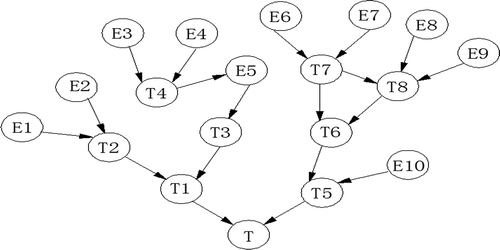
The probability of the bottom events is shown in :
Table 1. The probability of the bottom events
6. Discussion
According to the transformation formula (15) ~ (17) and (18) ~ (25) of the dynamic logic gate to the Bayesian network in the upper section, the conditional probability of each leaf node is obtained. In which assuming the sleep factor of the warm spare gates T8, = 0.2, the time interval
=1. A Bayesian network model of high-altitude falling accident is used to calculate the probability of a high fall accident is 22.1% by Bayesian simulation software Genie2.0, as shown in . According to the probability of a known height fall accident is 22.1%, uses the backward reasoning ability of the Bayesian network, can calculate the posterior probability of each bottom event, as shown in (where State 0 shows the event does not occur, State1 shows the incident occur). From the results of the analysis, the main event influencing the occurrence of high-altitude fall accident in construction site is barbaric construction, absenting of protection does not meet the requirements and not wearing a safety belt, and so on, which shows that the system once the failed (a high-altitude fall accident), it is likely that these aspects of the failure, so that the avoid measures should focus on these types of occupational safety risk factors. Along with the progress of architecture construction engineering, these occupational safety risk factors are constantly changing, and the structure of the dynamic fault tree should be constantly updated, so as to analyze the main occupational safety risk factors in different stages of the construction project life cycle.
Table 2. The posterior probability of the bottom events
7. Conclusions
There are already many types of research to study the occupational safety risk of architecture construction engineering, and these references are mainly focused on the static case, with no special concern about the complexity and variability of occupational safety risk of high-altitude fall accident in architecture construction engineering. In this paper, a novel integrated Dynamic Fault Tree Analysis (DFTA) and Bayesian network method is presented, including the definition of dynamic logic gates, the transformation of dynamic logic gates to Bayesian networks and the probability calculation, and apply it to the occupational safety analysis of high-altitude fall accident of architecture construction engineering. The main factors are obtained by using the Bayesian network simulation software GeNIe2.0, then can quantitative analysis the impact degree of various factors on the occurrence of the accident, can conclude that barbaric construction, absenting of protection does not meet the requirements and not wearing a safety belt are the major occupational safety risk of accident, provided an effective basis for the prevention and control of the accident.
The flowcharts and veracity of presented methods are mainly limited by the accuracy of the changed data, these changed data and information may contain substantial inaccuracies due to the imperfection of data acquisition ways in the high-altitude fall accident. As a result, the study has certain limitations. For this reason, the future direction of research is to study better data acquisition ways.
The presented analysis method can also be applied to other aspects of the construction project risk management, such as schedule risk, cost risk, quality risk, etc. The presented novel method and detailed realization process can offer a useful reference for the risk management of high-altitude fall accident in architecture construction engineering.
Disclosure statement
No potential conflict of interest was reported by the author.
Additional information
Funding
Notes on contributors
Xiao-Ping Bai
Xiao-Ping Bai is currently an associate professor in Xi’an University of Architecture & Technology, Xi’an; PRC . His research interests include project management, system engineering, and etc. His articles have appeared in Frontiers of Structural and Civil Engineering (SCIE), Kybernetes(SCIE), Discrete dynamics in nature and society(SCIE), Scientific World Journal(SCIE), Applied Mathematics & Information Sciences(SCIE), Tsinghua Science and Technology, etc.
Yu-Hong Zhao
Yu-hong Zhao is master in Xi’an University of Architecture & Technology, Xi’an; PRC. Her research interests include project management, system engineering, and etc.
References
- Abdo, H., and J.-M. Flaus. 2016. “Monte Carlo Simulation to Solve Fuzzy Dynamic Fault Tree.” IFAC Papers 49 (12): 1886–1891. doi:10.1016/j.ifacol.2016.07.905.
- Boudali, H., and J. Bechta Dugan. 2006. “A Continuous-time Bayesian Network Reliability Modeling, and Analysis Framework.” IEEE Transactions on Reliability 55 (1): 86–97. doi:10.1109/tr.2005.859228.
- Boudali, H., P. Crouzen, and M. Stoelinga. 2010. “A Rigorous, Compositional, and Extensible Framework for Dynamic Fault Tree Analysis.” IEEE Transactions on Dependable & Secure Computing 7 (2): 128–143. doi:10.1109/TDSC.2009.45.
- Chebila, M. 2018. “Bayesian Networks for Frequency Analysis in Dependability.” Journal of Failure Analysis & Prevention 18 (3): 538–544. doi:10.1007/s11668-018-0433-5.
- Chena, T.-T., and S.-S. Leub. 2014. “Fall Risk Assessment of Cantilever Bridge Projects Using Bayesian Network.” Safety Science 70: 161–171. doi:10.1016/j.ssci.2014.05.011.
- Chiacchio, F., M. Cacioppo, D. Durso, G. Manno, N. Trapani, and L. A. Compagno. 2013. “Weibull-based Compositional Approach for Hierarchical Dynamic Fault Trees.” Reliability Engineering and System Safety 109: 45–52. doi:10.1016/j.ress.2012.07.005.
- Codetta-Raiteri, D., and L. Portinale. 2017. “Generalized Continuous Time Bayesian Networks as a Modelling and Analysis Formalism for Dependable Systems.” Reliability Engineering & System Safety 167: 639–651. doi:10.1016/j.ress.2017.04.014.
- Dąbrowski, M., and J. Górski. 2019. “Influence of the Milling Tool Setup on Occupational Safety in Furniture Making.” International Journal of Occupational Safety and Ergonomics 25 (2): 1–30. doi:10.1080/10803548.2018.1514134.
- Dugan, J. B., S. J. Bavuso, and M. A. Boyd. 1993. “Fault Trees and Markov Models for Reliability Analysis of Fault-tolerant Digital Systems.” Reliability Engineering & System Safety 39 (3): 291–307. doi:10.1016/0951-8320(93)90005-J.
- Dugan, J. B., S. J. Bavuso, and M. A. Boyd. 1992. “Dynamic Fault-tree Models for Fault-tolerant Computer Systems.” IEEE Transactions on Reliability 41 (3): 363–377. doi:10.1109/24.159800.
- Ge, D., M. Lin, Y. Yang, R. Zhang, and Q. Chou. 2015. “Quantitative Analysis of Dynamic Fault Trees Using Improved Sequential Binary Decision Diagrams.” Reliability Engineering & System Safety 142: 289–299. doi:10.1016/j.ress.2015.06.001.
- Haddawy, P., A.H.M.I. Hasan, R. Kasantikul. 2018. “Spatiotemporal Bayesian Networks for Malaria Prediction.” Artificial Intelligence in Medicine 84: 127–138. doi:10.1016/j.artmed.2017.12.002.
- Kabir, S. 2017. “An Overview of Fault Tree Analysis and Its Application in Model Based Dependability Analysis.” Expert Systems with Applications 77: 114–135. doi:10.1016/j.eswa.2017.01.058.
- Kabir, S., M. Yazdi, J. I. Aizpurua, and Y. Papadopoulos. 2018. “Uncertainty Aware Dynamic Reliability Analysis Framework for Complex Systems.” IEEE Access 6: 29499–29515. doi:10.1109/ACCESS.2018.2843166.
- kabir, S., T. K. geok, M. kumar, M. yazdi, and F. hossain. 2020. “A Method for Temporal Fault Tree Analysis Using Intuitionistic Fuzzy Set and Expert Elicitation.” Ieee Access 8: 980–996. doi:10.1109/ACCESS.2019.2961953.
- Laitila, P., and K. Virtanen. 2016. “Improving Construction of Conditional Probability Tables for Ranked Nodes in Bayesian Networks.” IEEE Transactions on Knowledge and Data Engineering 28 (7): 1691–1705. doi:10.1109/tkde.2016.2535229.
- Lee, E., Y. Park, and J. G. Shin. 2009. “Large Engineering Project Risk Management Using a Bayesian Belief Network.” Expert Systems with Applications 36 (1): 5880–5887. doi:10.1016/j.eswa.2008.07.057.
- Leu, S.-S., and C.-M. Chang. 2015. “Bayesian-network-based Fall Risk Evaluation of Steel Construction Projects by Fault Tree Transformation.” Journal of Civil Engineering and Management 21 (3): 334–342. doi:10.3846/13923730.2014.890643.
- Manno, G., F. Chiacchio, L. Compagno, D. D’Urso, and N. Trapani. 2012. “An Integrated FT and Monte Carlo Simulink Tool for the Reliability Assessment of Dynamic Fault Tree.” Expert Systems with Applications 39 (12): 10334–10342. doi:10.1016/j.eswa.2011.12.020.
- Merle, G., J.-M. Roussel, and -J.-J. Lesage. 2011. “Algebraic Determination of the Structure Function of Dynamic Fault Trees.” Reliability Engineering and System Safety 96 (2): 267–277. doi:10.1016/j.ress.2010.10.001.
- Merle, G., J. M. Roussel, J. J. Lesage, and A. Bobbio. 2010. “Probabilistic Algebraic Analysis of Fault Trees with Priority Dynamic Gates and Repeated Events.” IEEE Transactions on Reliability 59 (1): 250–261. doi:10.1109/tr.2009.2035793.
- Merle, G., J.-M. Roussel, -J.-J. Lesage, V. Perchet, and N. Vayatis. 2016. “Quantitative Analysis of Dynamic Fault Trees Based on the Coupling of Structure Functions and Monte Carlo Simulation.” Quality and Reliability Engineering International 32 (1): 7–18. doi:10.1002/qre.1728.
- Miyauchi, Y., and H. Nishimura. 2016. “Construction and Evaluation of Bayesian Networks Related to the Specific Health Checkup and Guidance on Metabolic Syndrome.” Smart Innovation, Systems and Technologies 45: 183–193. doi:10.1007/978-3-319-23024-5_17.
- Mohammadfam, I., F. Ghasemi, O. Kalatpour, and A. Moghimbeigi. 2017. “Constructing a Bayesian Network Model for Improving Safety Behavior of Employees at Workplaces.” Applied Ergonomics 58: 35–47. doi:10.1016/j.apergo.2016.05.006.
- Rahme, J., and H. Xu. 2015. “A Software Reliability Model for Cloud-based Software Rejuvenation Using Dynamic Fault Trees.” International Journal of Software Engineering and Knowledge Engineering 25 (9–10): 1491–1513. doi:10.1142/S021819401540029X.
- Rauzy, A., and C. Blériot-Fabre. 2015. “Towards a Sound Semantics for Dynamic Fault Trees.” Reliability Engineering and System Safety 142: 184–191. doi:10.1016/j.ress.2015.04.017.
- Sutrisnowati, R. A., H. Bae, and M. Song. 2015. “Bayesian Network Construction from Event Log for Lateness Analysis in Port Logistics.” Computers and Industrial Engineering 89: 53–66. doi:10.1016/j.cie.2014.11.003.
- Tabar, V. R., and F. Elahi. 2018. “A Novel Method for Aggregation of Bayesian Networks without considering an Ancestral Ordering.” Applied Artificial Intelligence 32 (2): 1–14. doi:10.1080/08839514.2018.1451134.
- Vesely, W., J. Dugan, J. Fragola, J. Minarick, and J. Railsback. 2002. “Fault Tree Handbook with Aerospace Applications.” Technical Report Version 1.1. Washington, DC, USA: NASA Office Saf. Mission Assurance.
- Walker, M. 2009. “Pandora: A Logic for the Qualitative Analysis of Temporal Fault Trees.” Ph.D. dissertation, Dept. Comput. Sci., Univ. Hull, Hull, U.K.
- Xin Ge, W., L. Tang, and Y. Zhe. 2009. “Comprehensive Analysis Methods of Dynamic Fault Tree.” Equipment Manufacturing Technology 8: 22–24.
- Xing, L., O. Tannous, and J. B. Dugan. 2012. “Reliability Analysis of Nonrepairable Cold-standby Systems Using Sequential Binary Decision Diagrams.” IEEE Transactions on Systems, Man and Cybernetics, Part A (Systems and Humans) 42 (3): 715–726. doi:10.1109/tsmca.2011.2170415.
- Yazdi, M., S. Kabir, and M. Walkerb. 2019. “Uncertainty Handling in Fault Tree Based Risk Assessment: State of the Art and Future Perspectives.” Process Safety and Environmental Protection 131: 89–104. doi:10.1016/j.psep.2019.09.003.
- Yevkin, O. 2016. “An Efficient Approximate Markov Chain Method in Dynamic Fault Tree Analysis.” Quality and Reliability Engineering International 32 (4): 1509–1520. doi:10.1002/qre.1861.
- Zhu, P., Y. Guo, S. Si, and J. Han. 2017. “A Stochastic Analysis of Competing Failures with Propagation Effects in Functional Dependency Gates.” IISE Transactions 49 (11): 1050–1064. doi:10.1080/24725854.2017.1342056.
- Zhu, P., J. Han, L. Liu, and F. Lombardi. 2016. “Reliability Evaluation of Phased Mission Systems Using Stochastic Computation.” IEEE Transactions on Reliability 65 (3): 1612–1623. doi:10.1109/TR.2016.2570565.

